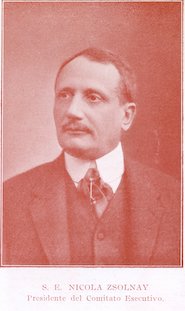Zsolnay, Miklos
 |
|
| Name: | Zsolnay, Miklos |
| Gender: | Male |
| Birth: | 1857, Pécs |
| Death: | 1922, Reckawinkel |
| Description: |
Miklos Zsolnay Jr. (1857-1922) served as President of the Executive Committee for the Pavilion of Hungary at the Exposition of Turin 1911. Miklos was the grandson of Miklos Szolnay Sr., who established the first Zsolnay ceramics factory in 1853, and the youngest son of Vilmos Szolnay. The Szolnay factory started as a brick factory, producing terracotta and earthenware pieces for building decoration. The factory became very successful under the management of Miklos's son, Vilmos Szolnay (1828-1900), who opened it up to the international markets via his participation to the World's Fairs in Vienna (1873) and Paris (1878). Vilmos experimented with different materials and techniques, settling on a new material "that stood somewhere between stoneware and porccelain" that he called "porcelain-faience" (Nefedova 59). Miklos Szolnay junior worked at his father’s side from the age of 16. He attended a vocational school (the Academy of Commerce and Industry) in Graz, Austria, and from 1897 he held the position of executive managing clerk, in charge of finances and trading. Following the sudden death of Vilmos in 1900, Miklos took over management and the proprietary rights of the factory, while the manufacturing part of the business was entrusted to his brothers in law, two artists proficient in matters of technology. Under Miklos' leadership, the factory expanded and established outlets in London and Paris, as well as Balkan markets. After the invention of eosin (a low-fire irridescent glaze) the Zsolnay ceramics became famous all over the world. Zsolnay designs are distinctive, while displaying numerous influences. Even though Hungary was under Ottoman rule for a relatively short period until 1686, the Turkish market remained important for Hungary. In 1877-78, Julia and Terez Zsolnay studied Persian and Indian ornamentation at the Osterreichisches Kunstgewerben Museum in Vienna, Austria, and the resulting items were displayed at the Paris World Exposition in 1878. In 1887-88 Miklos Szolnay traveled to Turkey, Syria and Egypt and the result was an increasingly strong Islamic influence on the Szolnay porcelain designs. Under Miklos Zsolnay Jr. the factory reached the peak of its international success, partnering with the best Hungarian architects and receiving awards in Hungary and abroad. In 1913, Miklos became a member of the Upper House of the Hungarian Parliament. Before getting married in 1911, he adopted the children of his sisters officially assigning to them the right of using his family name, securing for them, in this way, the right of inheritance. At the end of the First World War, Miklos Zsolnay suffered a nervous breakdown. In 1922, he died in the nursing home of Reckawinkel, in today's lower Austria. The factory continued to be managed by the Szolnay family until 1948 when it was nationalized and the production of decorative ceramics ceased. It was only in 1974 that the factory took the Zsolnay name again. For almost a century (1853-1948), the Zsolnay Porcelain Manufacturing Company of Pecs was owned by the Zsolnay family: "family members originated designs, supervised and trained ceramic workers, introduced stunning technical innovation in clay and glazes, and worked to promote the company in the international marketplace. by 1900 the spendid art ceramics of the Zsolnay manufactory, especially Art Nouveau pieces, had achieved highest recognition in world expositions throughout Europe and in the United States." (Soros 9). Though one may know the Zsolnay name for the magnificent Art Nouveau pieces, the Zsolnay's productions were eclectic, starting with the historicist pieces and contributions to the creation of a "national style" in the late nineteenth century and expanding into the architectural ceramics that still define the roofs and facades of numerous buildings in the city of Budapest today (for example, the Parliament Building and the Museum of Applied Arts). See: Éva Csenkey and Ágota Steiner, eds. Hungarian Ceramics from the Zsolnay Manufactory 1853-2001. New Haven: Yale University Press, 2002. Olga Nefedova. "Early Zsolnay Porcelain-Faience im the Tareq Rajab Museum." Ceramics Monthly (Jan 2004). 58-60. Susan Weber Soros, Foreword. Hungarian Ceramics from the Zsolnay Manufactory 1853-2001. Eds. Éva Csenkey and Ágota Steiner. New Haven: Yale University Press, 2002. 9-10. |
| Subjects: | People |
| Structures: |
 Pavilion of Hungary Pavilion of Hungary |
| Places: |
 Pécs Pécs  Reckawinkel Reckawinkel |
| Photographs: |
Miklos Zsolnay_Ritratto | Miklos Zsolnay_portrait
|
